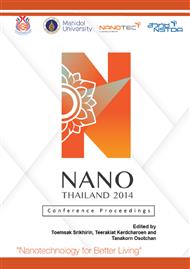[1]
E.C. Samano, A. Clemente, J.A. Diaz, G. Sota, Mechanical properties optimization of tungsten nitride thin films grown by reactive sputtering and laser ablation, Vacuum 85 (2010) 69-77.
DOI: 10.1016/j.vacuum.2010.04.004
Google Scholar
[2]
P.N. Silva, J.P. Dias, A. Cavaleiro, Performance of W-Ti-N coated pins lubricated pin-on-disk tests, Surf. Coat. Technol. 202 (2008) 2338-2343.
DOI: 10.1016/j.surfcoat.2007.09.039
Google Scholar
[3]
T. Polcar, A. Cavaleiro, Structure, mechanical properties and tribology of W-N and W-O coatings, Int. J. Refract. Met. H. 28 (2010) 15-22.
Google Scholar
[4]
G. Abadias, S. Dub, R. Shmegera, Nanoindentation hardness and structure of ion beam sputtered TiN, W and TiN/W multilayer hard coatings, Surf. Coat. Technol. 200 (2006) 6538-6543.
DOI: 10.1016/j.surfcoat.2005.11.053
Google Scholar
[5]
J.C. Caicedo, L. Yate, J. Montes, Improving the physicochemical surface properties on AISI D3 steel coated with Ti-W-N. Surf. Coat. Technol. 205 (2011) 2947-2953.
DOI: 10.1016/j.surfcoat.2010.11.005
Google Scholar
[6]
Q. Luo, S. Yang, K.E. Cooke, Hybrid HIPIMS and DC magnetron sputtering deposition of TiN coatings deposition rate, structure and tribological properties, Surf. Coat. Technol. 236 (2013) 13-21.
DOI: 10.1016/j.surfcoat.2013.07.003
Google Scholar
[7]
G.A. Zhang, P.X. Yan, P. Wang, Y.M. Chen, J.Y. Zhang, The structure and tribological behaviors of CrN and Cr-Ti-N coating, Appl. Surf. Sci. 253 (2007) 7353.
DOI: 10.1016/j.apsusc.2007.02.061
Google Scholar
[8]
L.R. Shaginyan, M. Misina, J. Zemek, J. Musil, F. Regent, V.F. Britun, Thin solid films 408 (2002) 136-147.
DOI: 10.1016/s0040-6090(02)00091-3
Google Scholar
[9]
S. Zhou, W. Liu, H. Liu, C. Cai, Structural and electrical properties of Ti-W-N thin films deposited by reactive RF sputtering, Physics Procedia 18 (2011) 66-72.
DOI: 10.1016/j.phpro.2011.06.059
Google Scholar
[10]
P. Homhuan, J. Pongsopa, K. Honglertkongsakul, Effect of nitrogen on the structural and electrical properties of Ti-W-N thin films, Burapa Science Journal Special volume (2014) 318-327.
Google Scholar
[11]
E.C. Samano, A. Clemente, J.A. Diaz, G. Sato. Mechanical properties optimization of tungsten nitride thin films grown by reactive sputtering and laser ablation, Vacuum 85 (2010) 69-77.
DOI: 10.1016/j.vacuum.2010.04.004
Google Scholar
[12]
J.C. Caicedo, L. Yate, J. Montes, Inproving the physicochemical surface properties on AISI D3 steel coated with Ti-W-N, Surf. Coat. Technol. 205 (2011) 2947-2953.
DOI: 10.1016/j.surfcoat.2010.11.005
Google Scholar
[13]
X. Liu, F. Yuan, Y. Wei, Grain size effect on the hardness of nanocrystal measured by the nanosize indenter, Appl. Surf. Sci 279 (2013) 159-166.
DOI: 10.1016/j.apsusc.2013.04.062
Google Scholar
[14]
M. Wen, Q.N. Meng, W.X. Yu, W.T. Zheng, S.X. Mao, M.J. Hua, Growth, stress, and hardness of reactively sputtered tungsten nitride thin film, Surf. Coat. Technol. 205 (2010) 1953-(1961).
DOI: 10.1016/j.surfcoat.2010.08.082
Google Scholar
[15]
N. Jiang, H.J. Zhang, S.N. Bao, Y.G. Shen, Z.F. Zhou, XPS study for reactively sputtered titanium nitride thin films deposited under different substrate bias, Physica B 352 (2004) 118-126.
DOI: 10.1016/j.physb.2004.07.001
Google Scholar
[16]
G. Sato, W. Cruz, M.H. Farias, XPS, AES, and EELS characterization of nitrogen-containing thin films, J. Electron. Spectrosc. 135 (2004) 27-39.
DOI: 10.1016/j.elspec.2003.12.004
Google Scholar
[17]
M. Oring, Material Science of Thin Films, second ed., Academic Press, San Diego, (2002).
Google Scholar
[18]
S. Khamseh, Synthesis and characterization of tungsten oxynitride films deposited by reactive magnetron sputtering, J. Alloy. Compd. 611 (2014) 249-252.
DOI: 10.1016/j.jallcom.2014.05.069
Google Scholar


